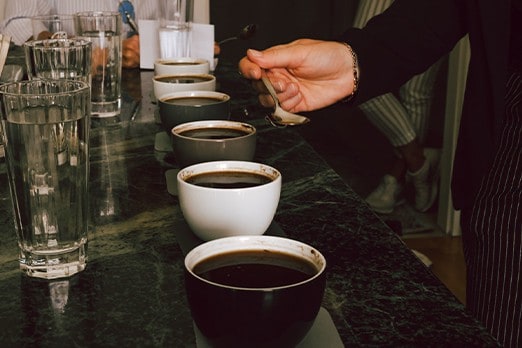All you need to know about coffee cupping
Cupping is an old methodology to analyze the sensory profile of coffees before they are sold to buyers. Why is it so essential and what is the proper way to do it?

Cupping is an idea that started already back in the 19th century, as it was used among merchants in coffee auctions.
Much later, around the end of the 20th century, it was standardized by two main organizations: Cup of Excellence and the Specialty Coffee Association (SCA).
It was used as a system to judge coffees in competitions of Cup of Excellence and was followed by SCA, who developed an official cupping form which has remained the standard evaluation for coffee up until today.
SO… WHAT IS CUPPING?
This semi-historic introduction made me realize that I still haven’t explained what cupping actually is.
Cupping, much like wine tasting, is made to evaluate and assess the product in its purest shape. It’s the ideal way to judge roasted coffee because tastings are blind, so the tasters cannot know which coffees they are about to try.
Another important aspect of coffee cupping is the simplicity of its brewing process: it is truly “brewing for dummies”. As we know, coffees have dozens of ways to be extracted and brewed – cupping is one of them of course, but cupping, in a way, is the most “naked”, pure and simple way to showcase the coffees’ #Characters.
You’ll need very straightforward equipment and conditions, and you’re good to go. You can do it anywhere, anytime. You’ll just need a boiler, a grinder, a cup, and a spoon. And some patience…
A BIT OF TECHNIQUE
Officially, according to the Specialty Coffee Association, grind size for cupping should be quite coarse (“…70-75 percent of the grinds pass through the 20 mesh sieve”), the water temperature of 96 degrees Celsius, and a ratio of 1-18 (more precisely, 8.25g of coffee to 150ml of hot water).
Some roasters prefer to change the ratio a little bit and increase the amount of coffee with the same amount of water, but generally speaking, the ratio always stays in the range of 1-16 to 1-18. I will avoid wearying you with the accurate details of the whole protocol, which could be easily found online on YouTube.
DISCOVER THE WIDE RANGE OF FLAVORS
Clearly, cupping is the best way to reveal the full range of aromas and flavors in coffee. Producers, exporters, importers, roasters, and even baristas (and some home baristas!) all use this protocol to evaluate new coffees they’ve never tried before.
There is no way to manipulate the hidden flavor notes of the beans through this method, unlike different extraction methods like espresso, Moka, or pour-overs, which can affect taste profiles significantly.
The differences between #Chill delicate and subtle coffees to #Fascinating intense, rich-bodied coffees will be very evident thanks to this simple methodology.
I warmly recommend you to do it with every new coffee you’re purchasing. Once you’ve cupped your new coffee, you can estimate its full potential and understand what could be the ideal method of extraction in the future; some coffees are delicious in a French press while others are shining in a V60 – cupping is a wonderful instrument to guide and navigate you towards the best possible result, consistently.
An interesting way to perceive cupping is through our imagination.
From a sensorial and scientific point of view, coffee shares many chemical compounds, identical to those which are present in fruits, vegetables, and many diverse foods.
For example, when we recognize some type of acidity while slurping an #Adventurous type of coffee, we should move forward thinking “is it acidic like tropical fruit, or more like vinegar? Is it delicate and mellow or rather sour and harsh? if it tastes like a fruit – which kind of fruit? Does it have the freshness of an orange or the sweet acids a strawberry has?”.
This goes on and on and should be applied to every aspect of the beverage: aroma, taste, mouthfeel, and aftertaste. The use of taste descriptors and flavor notes is very common and helpful nonetheless.
One of my favorite coffee professionals, James Hoffmann, often releases new videos on his YouTube channel, all about coffee from a different point of view. A year ago he’s released and simple guide on how to cup coffee at home, or you can also watch the official cupping protocol of SCA here.
Have a good Coffee Cupping and let us know about your experience!